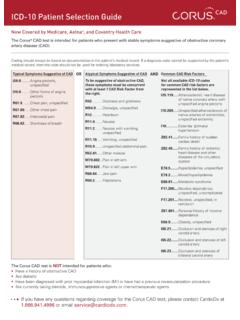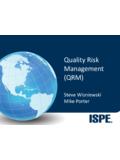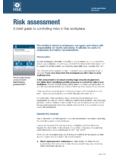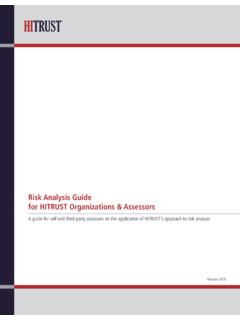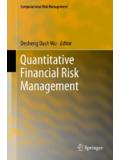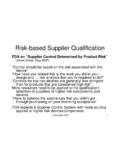Transcription of RISK MANAGEMENT GUIDE - Ministry of Finance
1 RISK MANAGEMENT GUIDE 1 June 2003 RISK MANAGEMENT GUIDE WORLD CUSTOMS ORGANIZATIONRISK MANAGEMENT GUIDE 2 June 2003 Table of Contents 1. Executive summary .. 4 2. 7 3. Definitions.
2 8 4. Steps to implement risk MANAGEMENT in Customs .. 9 The risk MANAGEMENT process .. 10 Compliance 12 Compliance Measurement Areas .. 13 The Measurement Process .. 14 Use of Compliance Measurement Results within the Control Programme 15 Supporting infrastructure .. 16 16 17 Use of information technology for effective implementation of Risk MANAGEMENT .. 18 Human Resource Development .. 19 Mutual administrative assistance.
3 19 5. Customs/Trade Co-operation .. 21 6. Conclusions .. 22 7. Example of a Customs control process .. 23 High-Level Scenario of a Customs control process .. 23 Low-Level Scenario of a risk MANAGEMENT 24 Low-Level Scenario of a post-clearance audit .. 25 8. 9. Appendix I : Local Selectivity 28 RISK MANAGEMENT GUIDE 3 June 2003 Appendix II : Selectivity Profile Filter Appendix III : CCC Recommendation on MAA.
4 30 Appendix IV : Methods of Application ..32 RISK MANAGEMENT GUIDE 4 June 2003 1. Executive summary Any organization benefits from the application of a risk MANAGEMENT strategy since this benefits organizational performance as a whole. Risk MANAGEMENT in any organization consists of well-defined steps which, when taken in sequence, support better decision making by contributing to greater insight into risks and their impacts.
5 For Customs administrations adoption of risk MANAGEMENT as an organizational philosophy is essential since it provides quantifiable improvements in the effectiveness and efficiency of the administration as a whole. Risk MANAGEMENT can operate in any organization with manual or automated application ranging from tactical to strategic approaches. It can be applied to nearly every decision-making situation. The WCO defines Risk MANAGEMENT as the systematic application of MANAGEMENT procedures and practices providing Customs with the necessary information to address movements or consignments which present a risk.
6 This focus is necessary since the fundamental task of the Customs is to control the movements or consignments across national frontiers and ensure compliance with national laws. When adopted as a MANAGEMENT philosophy it enables the Customs to not only carry out its key responsibilities effectively but also organize its resources and deploy them in a manner so as to improve its overall performance. Such a fundamental approach has the potential to radically improve effectiveness and efficiency and can help significantly in the ability to deploy resources towards the greatest areas of risk.
7 Risk MANAGEMENT should not be confused with risk assessment which comprises of a series of technical processes intended to identify and quantify individual risks . In the past, risk MANAGEMENT has been perceived as a process utilized only by highly developed customs administrations with automated and fully computerized systems. This is a misconception as risk MANAGEMENT programmes are relevant to all customs administrations. Effective risk MANAGEMENT can operate in any organisation with manual or automated application, ranging from tactical to strategic approaches.
8 Effective risk MANAGEMENT will require managers and staff to understand the nature of the risks in their work areas and systematically identify, analyse, evaluate, treat, monitor and review those risks . This process will provide MANAGEMENT and staff with a rigorous and defensible tool to assist in decision making. The benefits of risk MANAGEMENT to customs administrations can be categorized in the following way: - Achieving organizational objectives - Improved MANAGEMENT processes - Improved public and business profile.
9 The benefits emanating from these categories include: - Better use of existing resources, or the capacity to work with fewer resources - Dedicated resources to the greatest risk areas - Increased facilitation, flow of goods and inward investment Customs administrations operating in the modern global economy are faced with a complex range of challenges. The prime responsibilities remain the collection of revenues and the protection of society, but these demanding tasks must be performed effectively and efficiently, whilst at the same time facilitating the flow of legitimate goods.
10 Senior customs managers are also required to deliver RISK MANAGEMENT GUIDE 5 June 2003 greater outputs with the same, or fewer resources. Such changes require us to adopt a completely new approach to managing our customs business and to develop new strategies. The traditional customs methods of control, based upon percentage and random selection criteria, fall a long way short of our business objectives and expectations today.
